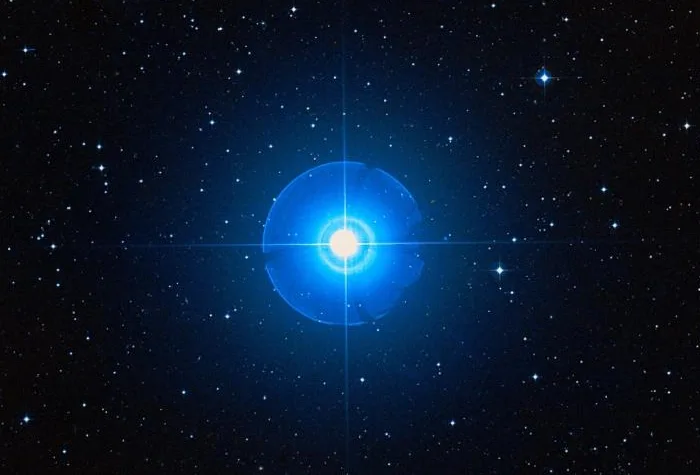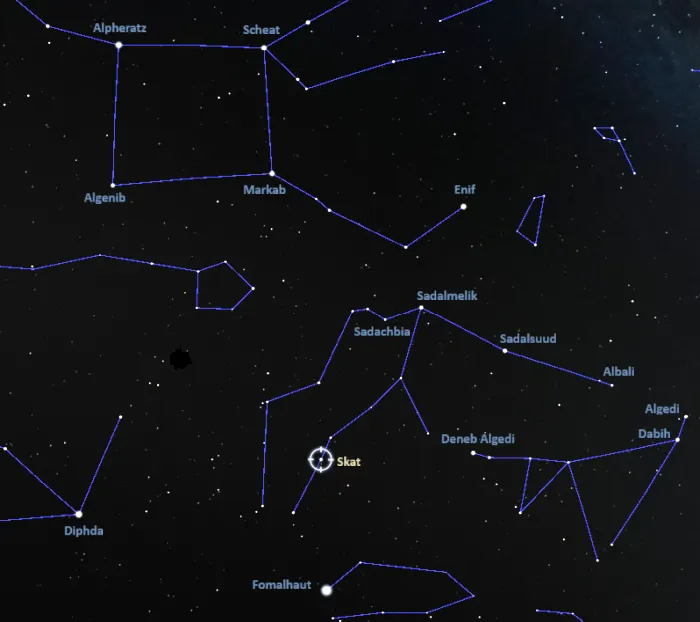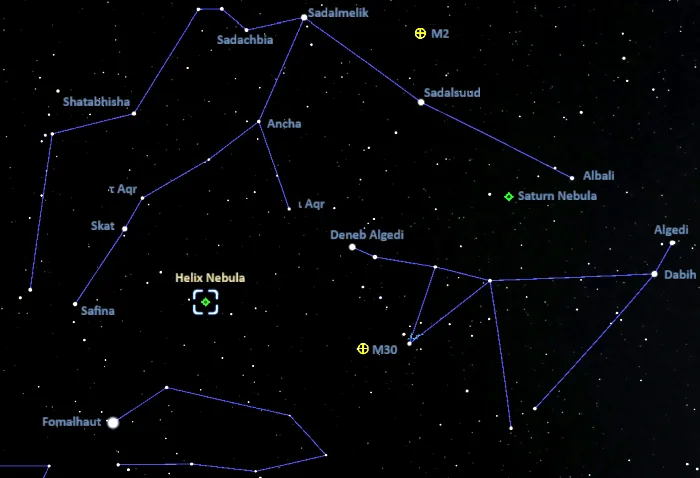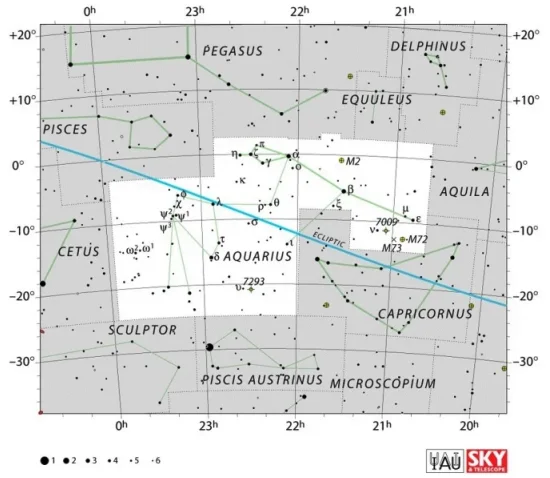Skat, Delta Aquarii (δ Aqr), is a binary star located 113 light-years away in the constellation Aquarius. With an apparent magnitude of 3.28, it is the third brightest star in the constellation, after Sadalsuud and Sadalmelik. It appears on the shin bone of the celestial Water Bearer.
Star system
Delta Aquarii is a spectroscopic binary star system with an estimated age of only 300 million years. It is composed of a white main sequence star of the spectral type A3Vp and a yellow dwarf with the spectral class G5. The two stars orbit each other with a period of 483 days at a distance of around 2 astronomical units (AU).
The primary component, formally known as Skat, is a chemically peculiar A-type dwarf with a mass 3.19 times that of the Sun and a radius of 4.16 solar radii. With an effective temperature of 8,650 K, it is 100 times more luminous than the Sun. The star is a fast rotator, with a projected rotational velocity of 81 km/s. It is moving away from the Sun at 10.96 km/s.

Skat (Delta Aquarii), image credit: ESO/Digitized Sky Survey 2 (CC BY 4.0)
Facts
Delta Aquarii was first reported to be an astrometric binary system by Goldin and Makarov in 2007 based on an analysis of data in the Hipparcos catalogue. The astronomers derived an orbital period of 483 ± 20 days, an inclination of 41±16°, and an eccentricity of 0.12 ± 0.2 for the system.
In 2011, Absil et al. directly detected the companion using infrared interferometry with the Very Large Telescope Interferometer (VLTI).
In 2016, observations with the HARPS instrument (High Accuracy Radial velocity Planet Searcher) at ESO’s La Silla 3.6m telescope unambiguously confirmed the presence of the spectroscopic companion.
Delta Aquarii is believed to be a stream member of the Ursa Major Moving Group, the nearest stellar association to the Sun. The core of the Ursa Major association lies approximately 80 light-years away and the members have an estimated age of 300 – 500 million years. The brightest members of the stellar family include the bright Big Dipper stars Alioth (Epsilon Ursae Majoris), Mizar (Zeta Ursae Majoris), Phecda (Gamma Ursae Majoris), Merak (Beta Ursae Majoris), and Megrez (Delta Ursae Majoris).
Other stream members of the group are scattered across the sky. They include Menkalinan (Beta Aurigae) in the constellation Auriga, Adhafera (Zeta Leonis) in Leo, Gamma Leporis in Lepus, Alphecca (Alpha Coronae Borealis) in Corona Borealis, Zhou (Beta Serpentis) in Serpens, Zeta Boötis in Boötes, and Chi1 Orionis in Orion.
With a visual magnitude of 3.28, Skat is the third brightest star in Aquarius and, on average, the 226th brightest star in the sky. It is slightly fainter than Brachium (Sigma Librae) in the constellation Libra, Sulafat (Gamma Lyrae) in Lyra, and Gamma Hydri in Hydrus. Delta Aquarii is about as bright as Delta Andromedae in Andromeda, Theta Ophiuchi in Ophiuchus and Mu Leporis in Lepus. It just outshines Omega Carinae in Carina, Edasich (Iota Draconis) in Draco, and Alpha Doradus in Dorado.
The radiant of the Delta Aquariids appears near Delta Aquarii. The meteor shower can be seen from July 14 to August 18, with the peak occurring around July 30 – 31 every year. It can be seen at around the same time as the better-known Perseids.
Name
The traditional name Skat (pronunciation: /ˈskæt/) comes from the Arabic word al-saq, meaning “the shin.” It appeared in the Arabic translation of Ptolemy’s Almagest. Other versions of the name included Scheat, Sheat, Scheat Edeleu, and Seat. The name Scheat now formally applies to Beta Pegasi, the second brightest star in the constellation Pegasus.
The International Astronomical Union’s (IAU) Working Group on Star Names (WGSN) approved the name Skat for Delta Aquarii on August 21, 2016.
In old Chinese astronomy, Skat was known as 羽林軍二十六 (Yǔ Lín Jūn ershíliù), the Twenty Sixth Star of Palace Guard. It formed the Palace Guard asterism with 44 fainter stars in the constellations Aquarius and Piscis Austrinus. The asterism was part of the larger Encampment mansion, one of the northern mansions of the Black Tortoise. It represented ancient imperial guards.
Location
Skat is relatively easy to find but can be a challenging target from light-polluted areas. It is the brightest point of light between Fomalhaut in the constellation Piscis Austrinus and Markab in Pegasus.
With an apparent magnitude of 1.16, Fomalhaut is the 18th brightest star in the sky. It can be found by extending a line from Scheat (Beta Pegasi) through Markab (Alpha Pegasi) in the Great Square of Pegasus.

Location of Skat (Delta Aquarii), image: Stellarium
Alternatively, Delta Aquarii can be found using the stars of Capricornus. A line extended from Dabih (Beta Capricorni) through Deneb Algedi (Delta Capricorni) points in its direction.
Skat can be used to find the famous Helix Nebula (NGC 7293, Caldwell 93), one of the brightest and largest planetary nebulae in the sky. The nebula forms a slightly elongated triangle with Skat and the fainter Safina (88 Aquarii). It lies roughly halfway between Iota Aquarii and Fomalhaut.

Skat and the Helix Nebula (NGC 7293), image: Stellarium
Constellation
Skat is located in the zodiac constellation of Aquarius. The celestial Water Bearer stretches across 980 square degrees of the predominantly southern sky and is the 10th largest of the modern constellations. It was one of the ancient constellations catalogued by the Greek astronomer Claudius Ptolemy of Alexandria in his Almagest in the 2nd century CE.
In Greek lore, the constellation is associated with Ganymede, the cup-bearer to the gods, and with Deucalion, son of Prometheus, who survived the mythical great flood.
In spite of its large size, Aquarius is inconspicuous in the night sky. Its brightest stars, the luminous yellow supergiants Sadalsuud and Sadalmelik (Beta and Alpha Aquarii) are third magnitude stars. They are the only stars in the constellation brighter than magnitude 3.0.
Other notable stars in Aquarius include the triple star system Zeta Aquarii, the central star in the Water Jar asterism, the binary systems Sadachbia (Gamma Aquarii), Albali (Epsilon Aquarii) and Bunda (Xi Aquarii), the red giant Shatabhisha (Lambda Aquarii), the evolved blue star Pi Aquarii, and the yellow star Ancha (Theta Aquarii).
Aquarius also hosts the nearby triple star EZ Aquarii, the symbiotic star R Aquarii, and the red dwarf TRAPPIST-1 with seven confirmed orbiting exoplanets.
Deep sky objects in the Water Bearer constellation include the bright globular clusters Messier 2 and Messier 72, the Helix Nebula (NGC 7293), the Saturn Nebula (NGC 7009), and the peculiar galaxies NGC 7727 and the Atoms for Peace Galaxy (NGC 7252).

Aquarius constellation map by IAU and Sky&Telescope magazine (Roger Sinnott & Rick Fienberg) (CC BY 3.0)
The best time of the year to see the stars and deep sky objects in Aquarius is during the month of October, when the constellation rises higher above the horizon in the early evening. The entire constellation can be seen from locations south of the latitude 65° N. As one of the equatorial constellations, Aquarius is easily visible from most locations for at least part of the year.
The 10 brightest stars in Aquarius are Sadalsuud (Beta Aqr, mag. 2.87), Sadalmelik (Alpha Aqr, mag. 2.942), Skat (Delta Aqr, mag. 3.28), Zeta Aquarii (mag. 3.65), Safina (88 Aqr, mag. 3.679), Shatabhisha (Lambda Aqr, mag. 3.722), Albali (Epsilon Aqr, mag. 3.77), Sadachbia (Gamma Aqr, mag. 3.849), 98 Aquarii (mag. 3.97), and Eta Aquarii (mag. 4.04).
Skat – Delta Aquarii
| Spectral class | A3Vp + G5V |
| U-B colour index | +0.08 |
| B-V colour index | +0.05 |
| Apparent magnitude | 3.28 |
| Absolute magnitude | −0.17 |
| Distance | 113 ± 3 light-years (34.7 ± 0.9 parsecs) |
| Parallax | 23.1451 ± 1.1614 mas |
| Radial velocity | +10.96 ± 1.98 km/s |
| Proper motion | RA: −34.152 ± 1.069 mas/yr |
| Dec.: −26.359 ± 0.846 mas/yr | |
| Mass | 3.19 M☉ |
| Luminosity | 100 L☉ |
| Radius | 4.16 R☉ |
| Temperature | 8,650 K |
| Metallicity | –0.21 dex |
| Age | 300 million years |
| Rotational velocity | 81 km/s |
| Surface gravity | 3.73 cgs |
| Constellation | Aquarius |
| Right ascension | 22h 54m 39.0062577912s |
| Declination | −15° 49′ 14.950434720″ |
| Names and designations | Skat, Delta Aquarii, Delta Aqr, δ Aquarii, δ Aqr, 76 Aquarii, 76 Aqr, HD 216627, HR 8709, HIP 113136, SAO 165375, FK5 866, BD−16 6173, GC 31943, GCRV 14380, PPM 240921, PLX 5552.00, SKY# 43516, GEN# +1.00216627, GSC 06387-01382, RAVE J225439.0-154914, HGAM 1092, JP11 3546, N30 5040, PMC 90-93 610, ROT 3333, UBV 19625, UBV M 26696, uvby98 100216627, WEB 20136, TD1 29440, TIC 111750833, YZ 106 8500, 2MASS J22543901-1549144, TYC 6387-1382-1, Gaia DR2 2404579569999907200, Gaia DR3 2404579570000684544 |